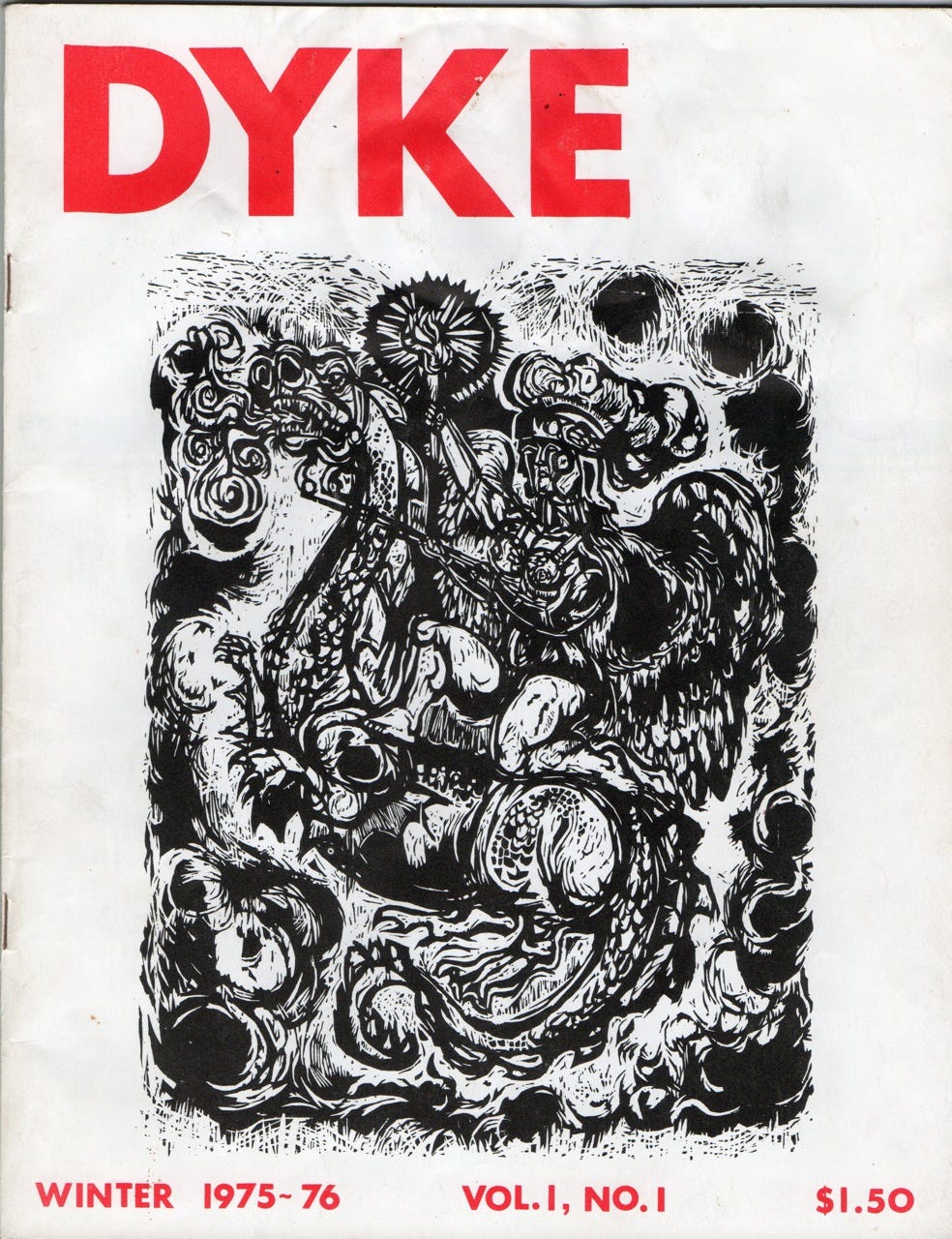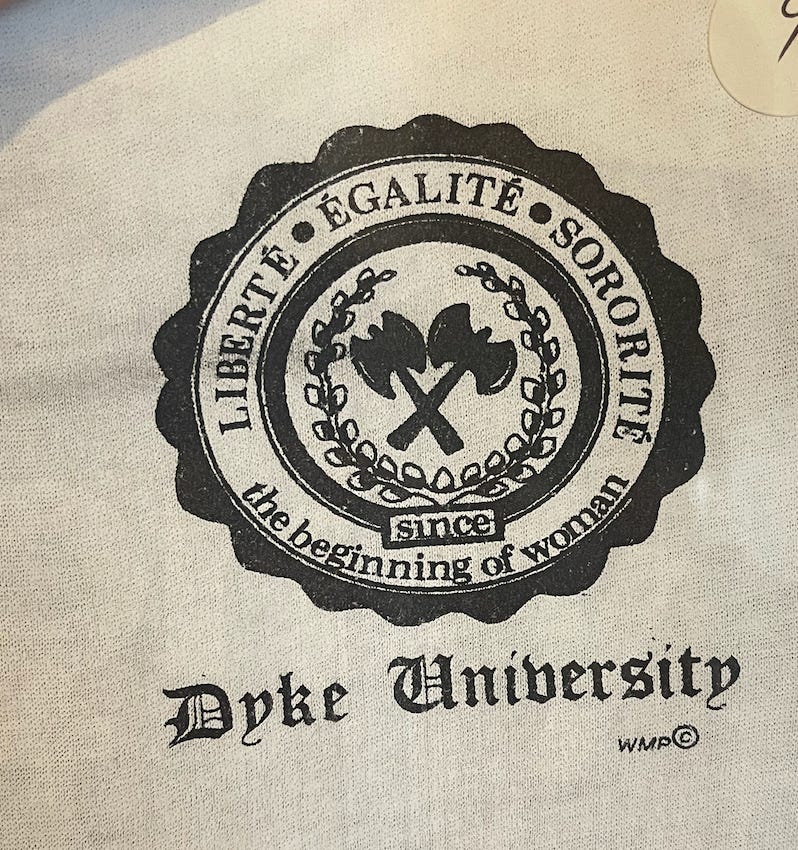Throughout history, some aspects of lesbian style have continued to grow and change while others have stood the test of time. One of the beautiful things about lesbian style is that there is no right or wrong way to do it; people span the spectrum from butch to femme, from sporty to cottagecore, and everything in between. Even still, as one of my friends recently told me of lesbian fashion, "I know it when I see it, but I can't quite describe it."
There is so much to explore throughout the history of lesbian fashion and how it has been used for lesbians to signal themselves to others. It's a way to forge community, friendship, and romance. As with many of the topics covered in this Substack, it would be impossible to go into every type of lesbian fashion throughout history in just one article, so today, we will go decade by decade, looking at one or two lesbian fashion trends from each decade explored.
1940s: The 1940s were a time that necessitated most lesbians and other queer women to hide their sexuality publicly. Because of this, fashion choices often centered around more discreet ways to signal their sexuality. One such example of this is the pinky signet ring, which was used by many lesbian women from the 1940s-1960s as a subtle way to broadcast to other women their sexuality. Even today, LGBTQ+ women will sometimes wear a pinky signet ring as a nod to our lesbian foremothers.
It wasn't just rings that were used to signal one's sexuality. For a briefer time than the pinky rings, some lesbians got nautical star tattoos. Often, the tattoos were on their wrists so that during the day, they could cover the tattoo with a watch. When they were out at night or amongst other potential lesbians, they could discreetly advertise their sexual preferences.
1950s: The 1950s brought with it many lesbian communities pressuring one another to choose to either dress hyper butch or hyper femme. It was a way to lean into the stereotypical gender roles that America was embracing, even within a women loving women relationship. As discussed in Odd Girls and Twilight Lovers A History of Lesbian Life in Twentieth-Century America by Lillian Faderman, the butch wore more masculine clothing while doing the 'mans' chores around the home while the femme wore extremely feminine clothing and did chores around the house such as cooking. In many ways, this era was focused more on heteronormativity, even within lesbian relationships.
1970s: By the time the 1970s rolled around, things had changed significantly from the 1950s and their leaning into gender roles. Some lesbian feminists formed the anti-fashion movement, where they focused on wearing clothing against the male gaze, including clothing with baggier silhouettes and bowties.
The anti-fashion movement wasn't the only lesbian fashion trend of the 1970s. In COWRIE Lesbian Feminist magazine, a column was started called, 'What the Well Dressed Dyke Will Wear,' written by Liza Cowan. The column later moved to the magazine Dyke a Quarterly. In the first edition after its move to Dyke a Quarterly, Cowan wrote of the fashion at the time, "Sometimes I forget how different we're looking these days. My eye has become so accustomed to our short cropped hair, baggy work trousers, vests, boots..."
1980s: A key facet of 1970s fashion that bled into the 1980s (and 90s) was political and otherwise opinionated t-shirts worn at rallies and publicly. Everything from shirts saying "encourage lesbianism" to a shirt with the quote saying "If I can't dance—I don't want to be part of your revolution." One of my favorite shirts from this era says, "Dyke University: since the beginning of women."
1990s: A unique turning point in the 1990s came when lesbian chic went mainstream. While some lesbians' style did match that of the specific style of androgyny shown in the media, it didn't truly encapsulate all lesbians. As Eleanor Medhurst in Dressing Dykes writes, "In many ways lesbian chic was never real, a media-fueled smokescreen used to commodify a population whose existence had always been appalling."
This Reddit thread has a lot of information on what lesbians in the 1990s were actually wearing; one user explained, "There weren't nearly as many openly lesbian women in the public eye. But I do recall a lot of plaid shirts, multiple earrings, DMs (Doc Martens), and undercuts/longer on top shaved at sides but asymmetrical haircuts were not a thing. It's like grunge style came in, and a load of lesbians went, 'YES, this is what I will wear for the rest of the decade.'"
Looking back and looking forward: Amidst the many styles and buzzwords of today's queer community, it may come as a surprise that some of these 'modern' styles have been around for many decades or even over a century. One such example is the 'cottagecore' style, a more simplistic natural life, often surrounded by fields, flowers, etc. Some cottagecore fashions include long dresses and flower crowns, while others are more natural and earthy. In 2020, this lifestyle seemed to really take off, but there are photos dating back as far as the 1920s of LGBTQ+ women who nowadays would be called 'cottagecore.'
Another great example is sporty lesbians–many lesbians play sports professionally, especially as women's sports continue to gain momentum. There are, of course, rec leagues for all types of sports, which queer women tend to flock to as well. Some may think this pastime and the fashion that comes with it is a new phenomenon, but that is not the case. As Professor Becki Ross wrote, "Targeted for being "deviants," "sinners," and "national security risks" in the 1940s and 1950s, some lesbians found solace, belonging and life-long love through involvement in sports."
Today: My style encapsulates many aspects of modern lesbian fashion as a way to signal to other LGBTQ+ women that I am one of them; this includes flannels, baggy pants, Doc Martens, rings, and quirky earrings. While the 1950s brought an era where there was pressure to choose to be masc or femme, today, the options for queer women are endless. Lesbians can and do look any way that feels best to them; it isn't about fitting a societal norm but rather allowing people to explore their unique identity through fashion.
While there are no queer fashion rules, it is fun to explore the history of lesbian fashion as a way to remember that we've always been here—whether hidden or in public. Through fashion and flagging, queer women have always found one another even with the odds stacked against them.







Hi friend! Do you mind if I reference this information in a zine about the history of lesbians?